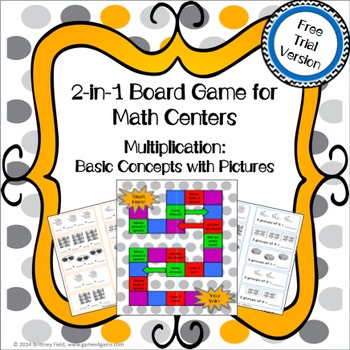- PDF
Description
This FREE Multiplication Board Games Pack gives you two different multiplication board games to play!
Skills covered in Multiplication Board Games Pack:
Use pictures to determine what "3 groups of 5" equals
Use pictures to solve repeated additions problems
When you download this resource, you'll get:
- Instructions for play
- Game board
- 60 game cards (30 cards for each of the 2 skills listed above)
Want the full edition? Check out 5-in-1 Math Board Game – Multiplication Basics with Pictures, which includes 90 more game cards:
Use pictures to determine what "2 fours" equals
Use pictures to write the addends in repeated addition problems
Use pictures to solve basic multiplication facts
Save 20%
Purchase the 5-in-1 Math Board Game Bundle that has all three of my 5-in-1 board games for a savings of 20%:
Multiplication Board Game (5-in-1) - Multiplication Basics
Multiplication Board Game (5-in-1) - Multiplication Arrays
Multiplication Board Game (5-in-1) - Multiplication Facts with Twos and Threes
Looking for other games for learning basic multiplication skills? Check out these multiplication games by Games 4 Gains:
Multiplication Concepts Bingo Game
Multiplication Concepts Board Game
Brainium Multiplication Board Game
*****************************************************************************
You might also like these other games by Games 4 Gains:
Rounding Numbers to Tens and Hundreds Board Game
Adding Numbers Within 1,000 Board Game
Subtracting Numbers Within 1,000 Board Game
Multiplying by Multiples of 10 Board Game
Fractions on a Number Line Board Game
Equivalent Fractions Board Game
Comparing Fractions Board Game
*****************************************************************************
Customer Tips:
Like this resource? Share with others!
• Pin this on Pinterest so others will find it! Just click on the Pin It button on the left side of this page or on the top right in your browser bar and share with others! Thank you!
How to get TPT credit to use on future purchases:
• Please go to your My Purchases page (you may need to login). Beside each purchase you'll see a Provide Feedback button. Simply click it and you will be taken to a page where you can give a quick rating and leave a short comment for the product. Each time you give feedback, TPT gives you feedback credits that you use to lower the cost of your future purchases. I value your feedback greatly as it helps me determine which products are most valuable for your classroom so I can create more for you. ☺
Be the first to know about my new discounts, freebies and product launches:
• Look for the green star next to my store logo and click it to become a follower. Voila! You will now receive email updates about this store. ☺
*****************************************************************************
This work is licensed under a Creative Commons Attribution-NonCommercial-NoDerivatives 4.0 International License.





